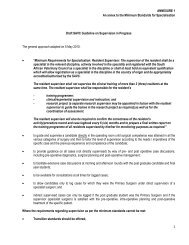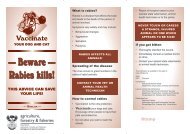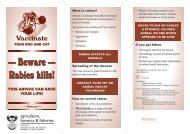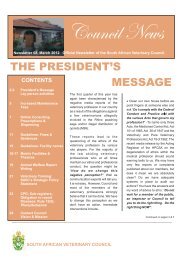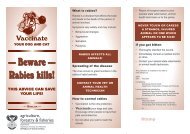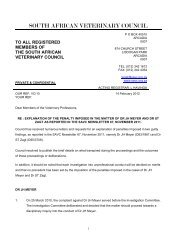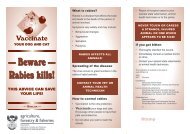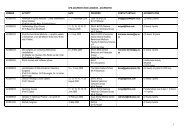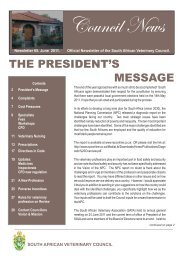Rabies Guide 2010.pdf - the South African Veterinary Council
Rabies Guide 2010.pdf - the South African Veterinary Council
Rabies Guide 2010.pdf - the South African Veterinary Council
You also want an ePaper? Increase the reach of your titles
YUMPU automatically turns print PDFs into web optimized ePapers that Google loves.
Appendix 2<br />
<br />
1. Assess <strong>the</strong> risk of transmission (page 36) and category of exposure (see B below)<br />
2. Record full details and history of <strong>the</strong> incident<br />
3. If risk of rabies is considered, proceed as indicated in <strong>the</strong> flow chart<br />
Animal not<br />
available for<br />
assessment<br />
Administer<br />
PEP (see B, C<br />
and D below)<br />
Administer PEP (see<br />
B, C and D below)<br />
Animal available for assessment<br />
AND<br />
Animal assessment by State Veterinarian/<br />
Veterinarian or dead animal sent to<br />
testing centres<br />
Animal healthy and alive after 10<br />
days of observation<br />
OR<br />
Laboratory testing at<br />
ARC-OVI or APVL<br />
Discontinue PEP<br />
Negative rabies test<br />
OR<br />
Positive rabies test<br />
A. Animal Assessment<br />
The following aspects must be considered:<br />
1. Vaccination: tangible proof of current rabies vaccination<br />
status (dog or cat) must be obtained. See constraints on<br />
page 36<br />
2. Behavioural changes: all aspects must be considered<br />
3. Possible exposure: any known incident during <strong>the</strong><br />
previous few months<br />
4. <strong>Rabies</strong> endemicity: entire RSA is rabies endemic but<br />
current incidence and prevalence are important<br />
5. Provocation: was <strong>the</strong> animal’s reaction due to<br />
provocation?<br />
6. Stray (unsupervised animals): this history may be<br />
unreliable<br />
B. Categories of rabies exposure<br />
Risk<br />
Cat.<br />
Type of<br />
exposure<br />
1 Touching/<br />
feeding animal<br />
Licking of intact<br />
skin<br />
2 Nibbling of<br />
uncovered skin<br />
Superficial<br />
scratch without<br />
bleeding<br />
3 Bites/scratches<br />
which penetrate<br />
<strong>the</strong> skin and<br />
draw blood<br />
Licking of<br />
mucous<br />
membranes or<br />
broken skin<br />
Action to be taken<br />
None if case history is reliable<br />
If history is not reliable, treat<br />
as for category 2<br />
Apply wound treatment<br />
Administer vaccine<br />
Do not administer antirabies<br />
immunoglobulin<br />
Stop vaccination if animal is<br />
rabies negative on laboratory<br />
test, or remains healthy after<br />
10 days observation<br />
Apply wound treatment<br />
Administer vaccine<br />
Administer antirabies<br />
immunoglobulin<br />
Stop vaccination if animal is<br />
rabies negative on laboratory<br />
test, or remains healthy after<br />
10 days observation<br />
C. Wound treatment<br />
1. Flush well with soap and water or water alone for at least 5<br />
minutes and apply disinfectant eg. 70% alcohol or iodine<br />
solution (eg. Betadine)<br />
2. Avoid suturing or use of compressive bandages<br />
3. Administer anti-tetanus treatment and antibiotics if<br />
indicated<br />
D. PEP schedules<br />
No previous immunization<br />
Category 2: Inject single dose vaccine into deltoid muscle<br />
(NEVER in gluteus) or antero-lateral thigh in children<br />
on days 0, 3, 7, 14 and 28<br />
Category 3: Infiltrate immunoglobulin (20 IU/kg) on day 0<br />
into and around wound, with remainder into deltoid of<br />
opposite arm to vaccine. Inject vaccine as for category<br />
2. <strong>Rabies</strong> immunoglobulin if not immediately available<br />
can be given up to 7 days of <strong>the</strong> first vaccine dose, but<br />
never after 7 days<br />
Previously immunized<br />
Category 2 and 3 exposures: Inject single dose vaccine<br />
into deltoid muscle on days 0 and 3. No rabies<br />
immunoglobulin should be given<br />
Special considerations<br />
Late presentation: Treat without delay as if <strong>the</strong> contact<br />
occurred recently, following <strong>the</strong> guidelines for wound<br />
treatment (where possible), and administration of<br />
immunoglobulin and vaccine. Deviation from <strong>the</strong><br />
suggested doses/regimens is not advised.<br />
Immunosuppressed patient: Emphasize thorough<br />
wound cleaning and ALWAYS administer antirabies<br />
immunoglobulin in both category 2 and 3 exposures in<br />
addition to <strong>the</strong> vaccine. Deviation from <strong>the</strong> number of<br />
doses and prescribed regimens is not advised.<br />
Bat exposures: PEP provides variable protection against<br />
rabies-related viruses. The categories of exposure do not<br />
apply to bats, as transmission can occur with very minor<br />
or even inapparent contact. Any close contact with bats<br />
is considered as a category 3 exposure.<br />
Fig. 7: Actions following a human exposure to a suspected rabid animal<br />
Continue PEP<br />
77





